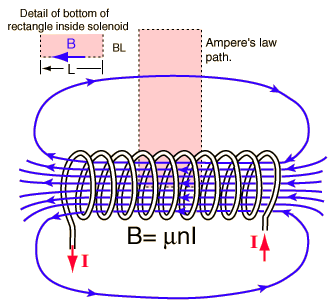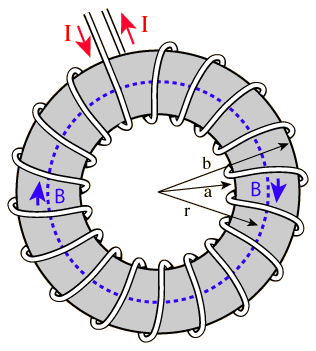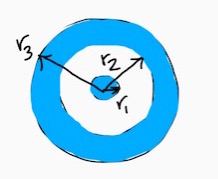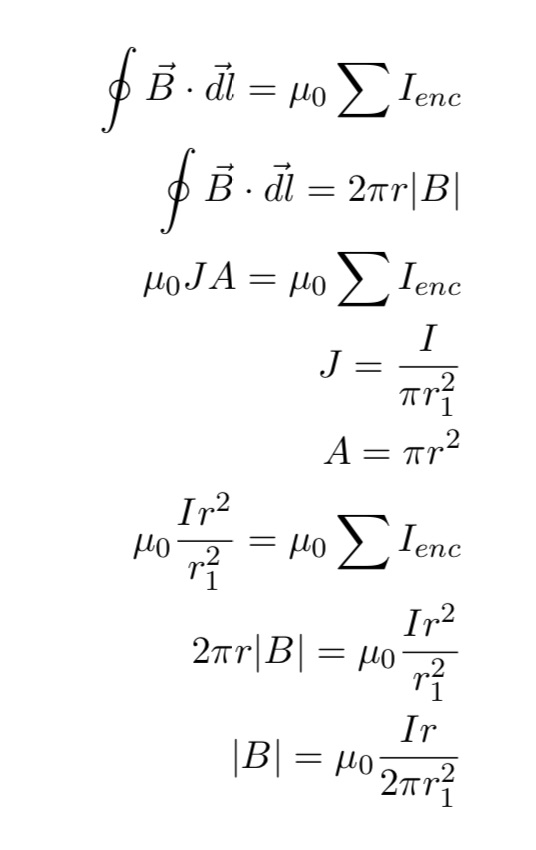Ampere's Law
Claimed by Ananyaveena Anilkumar Fall 2016
A much easier version of the Biot-Savart law that is useful for calculating the magnetic field within a closed path not a surface. This equation relates the magnetic field and the current to one another. Complete understanding of this topic makes other topics such as the nature of light easier to comprehend. Ampere's law is to the Biot-Savart law as Gauss's law is to Coulomb's law. Just as with Gauss's law, Ampere's law is relativistically correct, unlike the Biot-Savart law. When we say that the Biot-Savart law (like Coulomb's law) is not relativistically correct, we mean that it does not factor into account a time reference, and so it relies on situations where the speed of the source of interest are much less than the speed of light.
The Main Idea
A student is usually first taught how to find the magnetic field caused by the flow of individual charges and/ or currents. Ampere's law allows us to see a magnetic field and determine the currents that generate this field. Ampere’s law is a quantitative relationship between measurements of magnetic field a long a closed path and the amount and direction of the currents passing through that boundary. Ampere’s law is a quantitative relationship between measurements of magnetic field a long a closed path and the amount and direction of the currents passing through that boundary.
Here is a summary of the key steps in applying Ampere’s law:
1. Choose a (mathematical) closed path as a boundary.
2. Stretch an imaginary soap film over the boundary.
3. Walk around the boundary counterclockwise, integrating the field with the path.
4. Add up the positive and negative currents that pierce the soap film; this is ∑I inside path. Count as positive those currents that pierce the imaginary soap film coming out of the film (that is,in the direction of your right thumb with the fingers of your right hand curling around in the direction of your walk); currents that pierce the film going into the film are counted as negative.
5. Apply Ampere’s law, equating the two sums.
A Mathematical Model
- [math]\displaystyle{ \oint_C \mathbf{B} \cdot \mathrm{d}\boldsymbol{\ell} = \mu_0 \iint_S \mathbf{J} \cdot \mathrm{d}\mathbf{S} = \mu_0I_\mathrm{enc} }[/math]
A Computational Model
https://www.youtube.com/watch?v=jdsUQs9w0uw This links to a step by step video on how to use Ampere's Law to calculate the magnetic field of a toroid.
https://www.youtube.com/watch?v=IMoN6MVgOgA Magnetic Field in a Coaxial Cable from Ampere's Law
Examples
Be sure to show all steps in your solution and include diagrams whenever possible
Simple
1. Calculate the magnetic field of a solenoid with N number of turns at a point in the center of the solenoid.
1. Choose a path that has nonzero current intersecting it and includes the point at which the magnetic field is being calculated.
Let our path be the dotted rectangle with width (length parallel to solenoid) L.
2. Walk along the path counterclockwise, starting from the top-right corner of the rectangle.
3. Add up the individual contributions of each leg of the path. From the top right corner to the top left corner, the contribution is 0, since the magnetic field outside the solenoid is very small, we approximate it to be zero. From the top left corner to the bottom left corner, the contribution is again 0 since the path and the magnetic field are perpendicular to each other. Therefore, their dot product is 0. From the bottom left corner to the bottom right corner, the contribution is BL. From the bottom right corner to the top right corner, again the contribution is 0, because, again, the path and the magnetic field are perpendicular to each other.
4. Set the sum of contributions equal to [math]\displaystyle{ \mu_0 \Sigma I }[/math] Since this solenoid has N turns, we must multiply the current I by N.
[math]\displaystyle{ BL = \mu_0 NI }[/math]
[math]\displaystyle{ B = {{\mu_0 NI}\over L} }[/math]
2. Calculate the magnetic field of a toroid with N number of loops inside the toroid.
1. We pick our path to travel along the perimeter of the toroid, letting the path be a circle of radius r, which is between the inner and outer radii of the toroid.
2. The contribution is simply the product of B and the circumference of our imaginary circle (our path):
[math]\displaystyle{ B2 \pi r = \mu_0 N I }[/math]
[math]\displaystyle{ B = {{\mu_0 N I}\over {2 \pi r}} }[/math]
Difficult
Calculate the magnetic field at three different regions:
1) Inner blue region 2) White ring 3) Outer blue region
1)
Connectedness
- How is this topic connected to something that you are interested in?
An application of Ampere's law in an area that interests me is Maglev trains. It's fascinating how magnetic fields are strong enough to suspend the huge body that is a train. These trains do not use the same motors that are in regular trains. Instead they use electromagnets and guide the trains over a guideway, raising it approximately 0.39 and 3.93 inches. Because they float on air, this eliminates friction and allows the trains to reach speeds getter than 300 miles per hour. Damn. This excerpt from How Stuff Works indicates more about how they work- "Once the train is levitated, power is supplied to the coils within the guideway walls to create a unique system of magnetic fields that pull and push the train along the guideway. The electric current supplied to the coils in the guideway walls is constantly alternating to change the polarity of the magnetized coils. This change in polarity causes the magnetic field in front of the train to pull the vehicle forward, while the magnetic field behind the train adds more forward thrust."
- How is it connected to your major?
Because of the breadth of sub-fields and areas that make up mechanical engineering, there are many different applications of Ampere's laws. Every motor in the automotive industry makes use of magnetism. One of the most important components in the electric motors is the magnet. It supplies the rejection power to create circular or linear movement. cite http://www.magmamagnets.com/automotive
- Is there an interesting industrial application? cite http://www.gizmag.com/ge-magnetocaloric-refrigerator/30835/
An interesting industrial application that I've seen is also in the field of HVAC and involves refrigeration. And no it's not just the magnetism that lets you stick stuff on your fridge... The modern day fridge even though it's come a long way in terms of energy efficiency, still remains as the biggest leach of electricity in a household. Incorporating magnetism actually can have the effect of making refrigerators up to 30% more efficient than what's currently out there. It all started when the magnetocaloric effect, https://en.wikipedia.org/wiki/Magnetic_refrigeration when certain materials change temperatures in the presence of a varying magnetic field, was first observed. Such technology has not yet been implemented because of issues in how bulky it is. Michael Benedict, design engineer at GE Appliances describes it as being "about the size of a cart." That being said, be on the lookout in 10 or so more years when refrigerators based on this effect hit the markets!
Link to youtube video to embed: https://www.youtube.com/watch?v=WlKKKMTA7XM
History
André-Marie Ampère, the founder of classical electromagnetism, was a French mathematician and physicist born into a merchant family. Due to his father’s strong beliefs, André was self-educated in his huge library. Fast forward about 30 years and André had become a well-established professor of mathematics, philosophy and astronomy at the University of Paris. In 1820, André had established what was later known as Ampere’s law. He was able to demonstrate that two parallel wires can be oriented, with different current flows, in a manner that let them either attract or repel one another. Your boy established a relationship between the length of a current carrying wire and the strength of their currents. In 1827-28, André was elected as a Foreign Member of the Royal Swedish Academy of Science and a foreign member of the Royal Swedish Academy of Science. In 1881, a while after his death in 1836, the ampere, a standard unit of electrical measurement, was named after him.
See also
Are there related topics or categories in this wiki resource for the curious reader to explore? How does this topic fit into that context?
Further reading
Books, Articles or other print media on this topic
External links
Internet resources on this topic
References
This section contains the the references you used while writing this page
Section 22.6 PATTERNS OF MAGNETIC FIELD: AMPERE'S LAW pg. 914- 920
http://hyperphysics.phy-astr.gsu.edu/hbase/magnetic/amplaw.html#c1
http://teacher.pas.rochester.edu/phy122/Lecture_Notes/Chapter31/chapter31.html



